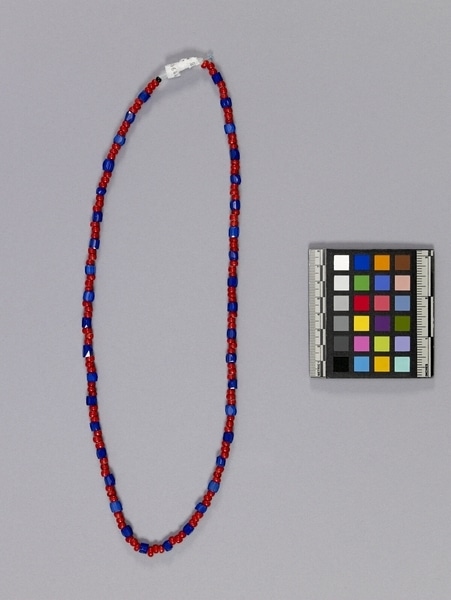Trade Beads Item Number: Nb644 from the MOA: University of British Columbia

Description
One hundred and twenty round, translucent red glass beads with opaque, white centres; thirty-nine translucent blue cylindrical, hexagonal, double chamfered glass cut beads; one round opaque black glass seed bead. (Strung on plastic string.)
History Of Use
Beads were extensively traded on the Northwest Coast from early trading contacts, throughout the 19th century. Facetted ultra-marine beads were commonly obtained in the north, from Russian traders, and the red beads were a typical Hudson's Bay Company item. Seed beads were common everywhere.
Narrative
The red and white beads are commonly called 'Hudson Bay beads' or cornaline d'allepo, and the facetted blue beads are called Russian beads, although they (and others) were probably made in Italy, France, or Czechoslovakia and distributed through various European cities, including Brussels. (The plastic string was added at acquisition.)
Cultural Context
Exchange; adornment.
Item History
- Made in Europe ? before 1935
- Collected in British Columbia, Canada
- Owned by Barnabas Cortland Freeman and Ida Freeman
- Owned by John E. Gibbard and I. Doreen Freeman before August 31, 1976
- Received from I. Doreen Freeman (Donor) and John E. Gibbard (Donor) on August 31, 1976
What
Who
- Culture
- Northwest Coast
- Previous Owner
- Barnabas Cortland Freeman, Ida Freeman, John E. Gibbard and I. Doreen Freeman
- Received from
- I. Doreen Freeman (Donor) and John E. Gibbard (Donor)
Where
- Holding Institution
- MOA: University of British Columbia
- Made in
- Europe ?
- Collected in
- British Columbia, Canada
When
- Creation Date
- before 1935
- Ownership Date
- before August 31, 1976
- Acquisition Date
- on August 31, 1976
Other
- Condition
- good
- Current Location
- Case 42
- Accession Number
- 0320/0035